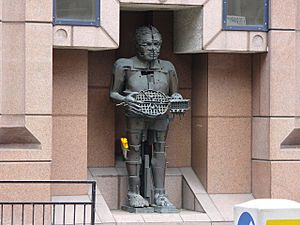The Artist as Hephaestus facts for kids
The Artist as Hephaestus is a cool bronze statue made by a famous artist named Sir Eduardo Paolozzi in 1987. It shows a tall person, who is actually Paolozzi himself, looking like he's walking. The statue is about 2.64 meters (nearly 9 feet) tall. It is holding two round, pierced objects that look a bit like sieves.
Contents
About the Sculpture
Who is Hephaestus?
Hephaestus (pronounced He-FESS-tus) is a god from ancient Greek stories. He was known as the god of blacksmiths, metalworking, fire, and volcanoes. He made amazing weapons and tools for the other gods. Paolozzi named his sculpture after Hephaestus because he was also a creator, like a modern-day metalworker.
Where Was It First?
This impressive statue was specially made for a new office building in London, at 34–36 High Holborn. It was placed in a special spot on the building's front in 1987. It stayed there for many years, until late 2012.
Moving and Finding a New Home
In 2012, the building was going to be updated, so the sculpture was carefully taken down. It was put up for sale at an auction, but it didn't sell right away. Later, in 2014, an art dealer named Wentworth Beaumont bought it.
How It Was Created
The idea for this big statue started with a bronze bust (a sculpture of someone's head and shoulders) of Paolozzi. This bust was made by an artist named Celia Scott in 1983. Celia Scott gave Paolozzi a plaster copy of her work.
Paolozzi then made his own plaster self-portrait in 1987, using Scott's work as a starting point. He also made two smaller bronze models before creating the final large statue. One of these models was called Selfportrait with a Strange Machine and was about 85 centimeters (33 inches) tall. Another was called Portrait of the Artist as Vulcan (Vulcan is the Roman name for Hephaestus) and was 150 centimeters (59 inches) tall. These smaller versions helped him plan the big sculpture.
Paolozzi later gave a full-sized plaster and polystyrene version of The Artist as Hephaestus to the National Portrait Gallery in 1990.


